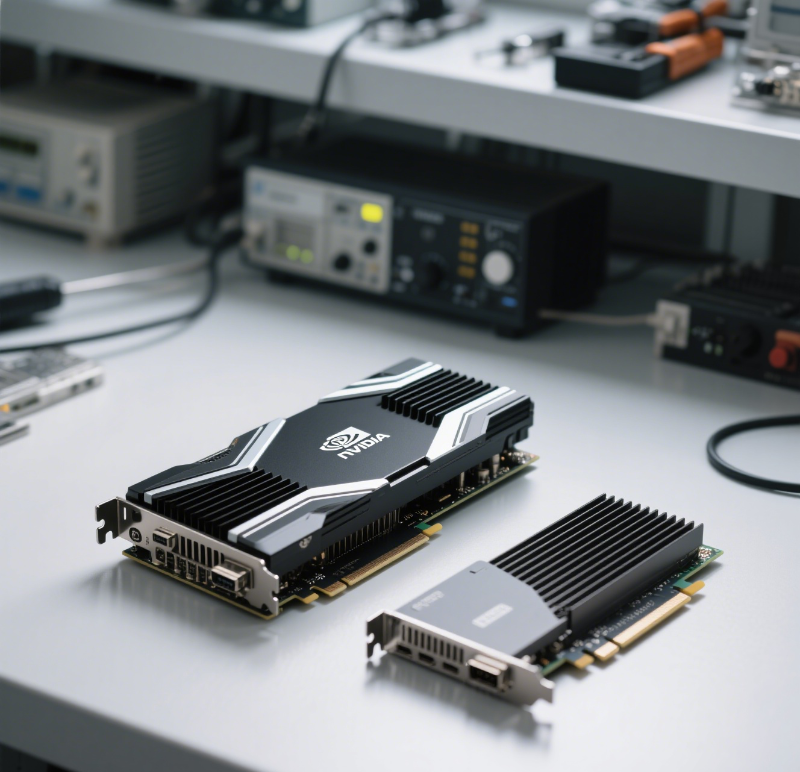1. Introduction
“GPU” and “graphics card.” You hear these terms thrown around constantly, often used as if they mean the exact same thing – especially when talking about AI and high-performance computing. But should they be used interchangeably? The short answer is no. Understanding the precise distinction between these two concepts isn’t just tech trivia; it’s absolutely critical for AI enterprises looking to scale their compute resources efficiently and cost-effectively. Misunderstanding these terms can lead to poor infrastructure decisions, wasted spending, and bottlenecks in deploying critical applications like large language models (LLMs). For AI teams navigating the complex landscape of hardware, optimizing GPU infrastructure isn’t a semantic game—it’s a strategic necessity. Tools like WhaleFluxturn this technical clarity directly into tangible cost savings and performance gains. Let’s break it down.
2. The GPU vs. Graphics Card Conundrum
The confusion is understandable, but the difference is fundamental.
A. What is a GPU?
Definition: The GPU, or Graphics Processing Unit, is the processor itself. It’s a specialized electronic circuit designed to rapidly manipulate and alter memory to accelerate the creation of images, videos, and animations intended for output to a display. However, its true power lies in its massively parallel architecture, making it exceptionally good at handling the complex mathematical calculations required not just for rendering graphics, but for scientific computing, simulations, and crucially, Artificial Intelligence.
Role in AI: In the world of AI, the GPU is the undisputed workhorse. Training complex deep learning models, especially Large Language Models (LLMs) like GPT-4 or Llama, involves performing trillions of calculations on massive datasets. The parallel processing capabilities of GPUs make them orders of magnitude faster and more efficient at these tasks than traditional Central Processing Units (CPUs). They are the literal heart of modern AI training and inference.
B. What is a Graphics Card?
Definition:
A graphics card (also known as a video card, display card, or GPU card) is the physical hardware component you install into a computer or server. It’s a printed circuit board (PCB) that houses several key elements:
- The GPU (the actual processing chip).
- Video RAM (VRAM): High-speed memory dedicated solely to the GPU for storing textures, frame buffers, and model data.
- Cooling System: Fans and/or heatsinks to dissipate the significant heat generated by the GPU.
- Power Delivery: Components to regulate and deliver the high power the GPU requires.
- Output Ports: Connectors like HDMI or DisplayPort for monitors.
- Interface: Typically PCI Express (PCIe) for connecting to the motherboard.
Key Insight:
Think of it this way: The “graphics card” is the complete package – the housing, power, cooling, and memory – built around the core GPU processor. Saying “graphics card” refers to the tangible device you hold, while “GPU” refers specifically to the computational engine inside it. You can have a GPU integrated directly onto a computer’s motherboard or even within a CPU (integrated graphics), but when we talk about the powerful hardware driving AI, we’re almost always talking about dedicated GPUs housed on discrete graphics cards or integrated into specialized servers.
C. Critical Differences
- GPU: A specialized processing unit focused on parallel computation. It can exist in integrated form (on a CPU or motherboard) or dedicated form (on a graphics card or server module).
- Graphics Card: A complete, standalone hardware product containing a GPU, its own dedicated memory (VRAM), power regulation, and cooling.
- Enterprise Context: For AI companies, this distinction is paramount. Scalability and performance aren’t just about how many physical graphics cards you can cram into a server rack. True AI scalability hinges on efficiently utilizing the raw computational power – the GPU density and efficiency – within those cards. Simply adding more cards without optimizing how the GPUs themselves are used leads to diminishing returns and wasted resources. Maximizing the throughput of each individual GPU is key.
3. Why the Distinction Matters for AI Companies
Understanding that a graphics card contains a GPU (or sometimes multiple GPUs, like in the NVIDIA H100 NVL) is more than academic for AI businesses. It directly impacts the bottom line and operational success.
A. Resource Allocation
In complex AI environments, workloads are rarely distributed evenly across all available hardware. Without sophisticated management, GPUs within a multi-node cluster can sit idle while others are overloaded. Underutilized GPUs represent pure, wasted spend. You’re paying for expensive hardware (whether owned or rented) that isn’t contributing to your computational goals. This inefficiency stems from managing at the graphics card or server level, rather than dynamically allocating tasks at the individual GPU level across the entire cluster.
B. Cost Implications
The cost of high-end AI-grade graphics cards (housing powerful GPUs like H100s or A100s) is substantial, both in upfront capital expenditure (CapEx) and operational expenditure (OpEx) like power and cooling. Deploying excess graphics cards to handle peak loads or due to poor utilization is incredibly expensive. Conversely, optimizing GPU throughput – ensuring every GPU cycle is used productively – significantly reduces the number of cards (and associated costs) needed to achieve the same or better results. This optimization directly translates to lower cloud bills or better ROI on owned hardware.
C. Stability & Speed
AI model training and inference, particularly for LLMs, demand consistent, high-bandwidth access to GPU resources. Inconsistent GPU allocation – where tasks are starved for compute cycles or memory access – causes significant slowdowns, failed jobs, and unreliable deployments. Training runs can stall for hours or days if a GPU fails or becomes overloaded. For inference serving, latency spikes due to resource contention create poor user experiences. Achieving the speed and stability required for production AI hinges on smooth, predictable access to GPU power across the cluster.
4. Optimizing Enterprise GPU Resources with WhaleFlux
This is where the distinction between the GPU (the processing power) and the graphics card (the hardware container) becomes an actionable strategy. WhaleFlux is an intelligent GPU resource management platform designed specifically for AI enterprises to solve the challenges of cost, utilization, and stability by focusing on optimizing the core resource: the GPU itself.
A. Intelligent GPU Management
WhaleFlux operates at the GPU level, not just the server or card level. It acts as an intelligent orchestration layer for your multi-GPU infrastructure, whether on-premises, in the cloud, or hybrid. WhaleFlux dynamically allocates workloads across all available GPUs within your cluster, regardless of which physical server or graphics card they reside in. It understands the capabilities and current load of each individual GPU – including diverse types like NVIDIA H100, NVIDIA H200, NVIDIA A100, and NVIDIA RTX 4090 – and assigns tasks accordingly. This ensures the right workload runs on the right GPU at the right time, maximizing overall cluster efficiency.
B. Cost Efficiency
By eliminating GPU idle time and preventing resource fragmentation, WhaleFlux dramatically increases the utilization rate of your existing GPU investment. This means you can achieve more computational work with the same number of GPUs, or potentially reduce the total number required. WhaleFlux’s sophisticated cluster utilization analytics provide deep insights into usage patterns, bottlenecks, and inefficiencies. Armed with this data, companies consistently reduce their cloud spend by 30% or more by rightsizing their infrastructure and avoiding over-provisioning based on peak, unoptimized demand.
C. Flexible Deployment
WhaleFlux offers unparalleled flexibility in how you access and manage powerful NVIDIA GPUs. Need dedicated hardware? You can purchase WhaleFlux-managed servers equipped with the latest H100, H200, A100, or RTX 4090 GPUs, benefiting from the platform’s optimization from day one. Prefer a leaner operational model? Lease WhaleFlux-managed GPUs within our optimized infrastructure. This leasing model provides access to top-tier compute power without massive upfront CapEx, perfect for scaling teams or specific project needs. Importantly, WhaleFlux is tailored for sustained AI workloads. We understand that training LLMs or running continuous inference requires stability, not ephemeral bursts. Therefore, we offer lease terms starting at a minimum of one month, ensuring the dedicated resources and predictable pricing essential for serious AI development and deployment. (We do not offer disruptive per-hour billing).
D. Stability for LLMs
For Large Language Model operations, stability is non-negotiable. WhaleFlux proactively monitors GPU health, load, and network paths. It intelligently routes tasks around potential failures or hotspots, ensuring high availability. By eliminating bottlenecks caused by uneven load distribution or failing nodes, WhaleFlux provides a rock-solid foundation. Customers experience significantly fewer job failures and interruptions. The result? Businesses deploy models up to 50% fasterthanks to reliable, optimized resource access, and enjoy zero unexpected downtime during critical inference serving, ensuring a seamless experience for end-users.
5. Key Takeaways
GPU ≠ Graphics Card:
Remember the core distinction: The GPU is the specialized parallel processor, the engine. The graphics card is the complete physical hardware package housing the GPU, its memory, power, and cooling. Confusing them leads to imprecise planning.
AI Success Demands GPU Efficiency:
For AI companies, scaling effectively isn’t just about buying more graphics cards. True efficiency and cost control come from maximizing the utilization and throughput of every single GPU within your infrastructure. Idle GPUs are wasted money.
WhaleFlux Solution:
WhaleFlux transforms your GPUs from potential sunk costs into strategic assets. By providing intelligent, dynamic management of NVIDIA H100, H200, A100, and RTX 4090 resources across clusters, WhaleFlux delivers substantial cost savings (30%+), dramatically faster and more stable LLM deployments (50% faster deployment, zero downtime), and flexible access models (purchase or lease, min. 1 month). It brings clarity to your compute strategy by focusing on optimizing the critical resource: GPU processing power.
6. Conclusion
In the high-stakes world of artificial intelligence, semantics aren’t just about words; they shape your infrastructure decisions and ultimately, your profitability. Precision in understanding your core compute resources – recognizing that harnessing the power of the GPU itself is distinct from managing the graphics card hardware – is the first step towards building an efficient, scalable, and cost-effective AI operation. Tools like WhaleFlux embody this precision, turning the abstract concept of GPU optimization into concrete results: lower costs, faster deployments, and unwavering stability. By focusing on maximizing the value of every GPU cycle, WhaleFlux empowers AI enterprises to focus on innovation, not infrastructure headaches. Ready to optimize your GPU cluster and turn compute power into a competitive advantage?
Explore WhaleFlux’s H100, H200, and A100 Solutions Today.

